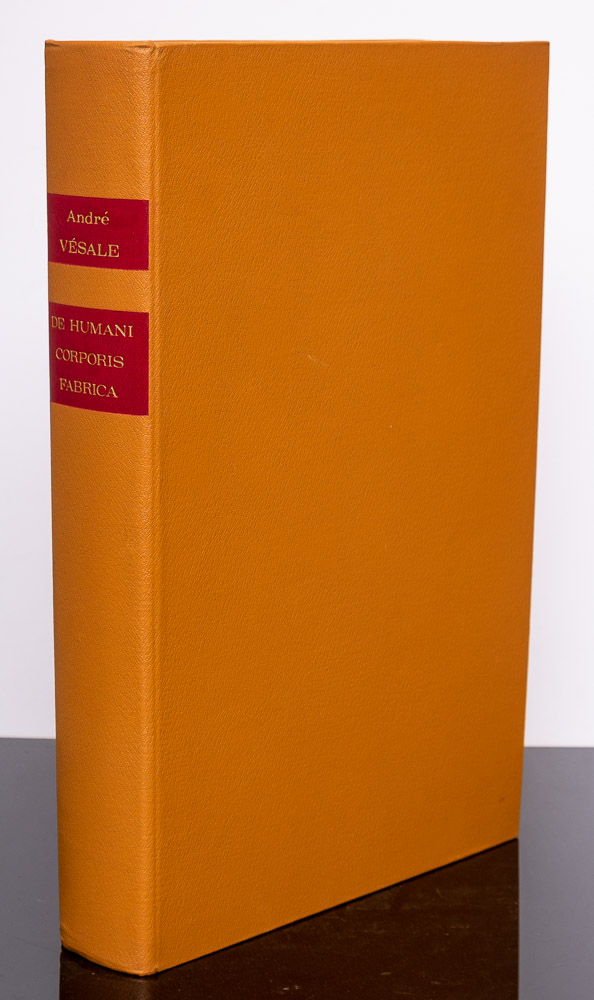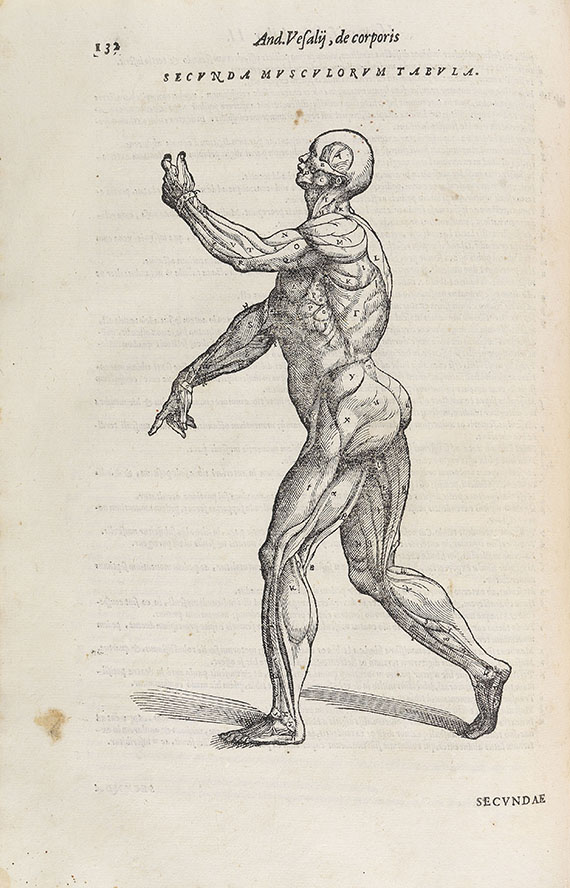VESALIUS, Andreas (1514-1564). De humani corporis fabrica libri septem . Basel: Johannes Oporinus, June 1543.
VESALIUS, Andreas (1514-1564). De humani corporis fabrica libri septem . Basel: Johannes Oporinus, June 1543. Royal 2° (411 x 278mm). Roman, italic, Hebrew and Greek types. With the two folding sheets following m2 and p3, the single leaf ('Charta parvas aliquot figuras complectens') tipped onto folding sheet m3. Woodcut pictorial title in first state, author portrait, over 200 woodcut illustrations, including 3 full-page skeletons and 14 full-page muscle-men, printer's device at end, and many woodcut historiated and ornamental initials from several sets. (Neat tear just into image of Q1, marginal wormtrack in S2-T1, repaired marginal tear without loss in *2 and Ll3, a few fore-edges chipped, some spotting, minor marginal dampstain in final quire, neat tear in woodcut without loss in folding sheet p4 repaired on verso.) 18th-century vellum over thin pasteboard, title lettered on spine, speckled edges (darkened, repaired at extremities, splits at joints; modern cloth folding box). Provenance : Alberto Lollio (1508-68; poet, playwright, scholar; title inscription partly obscured) -- Gennaro Giannelli (Neapolitan medical doctor; 18th-century title inscription) — Dr. Martin Tupper, FRS (1780-1844; medical doctor; armorial bookplate; his donation recorded by the Royal Institution on 30 July 1845). 'THE MOST FAMOUS ANATOMICAL WORK EVER PUBLISHED, ... AND THE MILESTONE IN ALL MEDICAL HISTORY' ( Heirs of Hippocrates ). The Fabrica is 'a complete anatomical and physiological study of every part of the human body ... [dealing] with bones and muscles, blood vessels, nerves, abdominal viscera, thoracic organs and the brain' (PMM). Benefitting from the then-radical practice of dissecting the human body rather than animals, Vesalius broke new ground in his method and observations, thus fundamentally dividing the study of anatomy into pre- and post-Vesalian periods. The Fabrica is widely considered the most beautiful medical book ever published. It combines scientific exposition, art and typography in a manner unprecedented in the 16th century and rarely equalled in later centuries. The more than 200 woodblocks for the illustrations were prepared in Venice by an anonymous artist in the school of Titian under Vesalius's supervision and shipped to the publisher in Basel with the author's precise instructions for placing them in relation to the text and for keying explanations printed in the margins to particular illustrations or details. The woodcuts were highly influential and were re-used or copied for over a century; the woodblocks themselves survived in Germany up to the Second World War. The work opens with a full-page scene of an anatomical theatre showing the dissection of a female corpse in progress; Vesalius performed one of the earliest autopsies on a female body. The 14 muscle-men stand in landscapes that together form a panorama of the Euganean Hills near Padua, where Vesalius studied and wrote his magnum opus , and even the woodcut initials, cut specially for this edition, depict activities associated with the dissecting room. The present copy has formed part of the library of a contemporary man of letters and, subsequently, two physicians. Alberto Lollio was a noted literary figure in Renaissance Ferrara. Poet, playwright, champion of the Tuscan language, and founder and member of numerous academic and literary societies, Lollio was a strict contemporary of Vesalius and was married to the daughter of the celebrated physician Sigismondo Nigrisoli. Gennaro Giannelli was a Neapolitan doctor of the first half of the 18th century, whose extensive library has been noted; Martin Tupper was physician to the Duke of Wellington, who turned down two offers of a baronetcy, first from Lord Liverpool and second from the Duke of Wellington. He was the father of Martin Farquhar Tupper, writer and poet. Adams V-603; Dibner, Heralds of Science 122; Garrison-Morton 375; Heirs of Hippocrates 281; Grolier Medicine 18A; NLM/Durling 4577; PMM 71; W
VESALIUS, Andreas (1514-1564). De humani corporis fabrica libri septem . Basel: Johannes Oporinus, June 1543.
VESALIUS, Andreas (1514-1564). De humani corporis fabrica libri septem . Basel: Johannes Oporinus, June 1543. Royal 2° (411 x 278mm). Roman, italic, Hebrew and Greek types. With the two folding sheets following m2 and p3, the single leaf ('Charta parvas aliquot figuras complectens') tipped onto folding sheet m3. Woodcut pictorial title in first state, author portrait, over 200 woodcut illustrations, including 3 full-page skeletons and 14 full-page muscle-men, printer's device at end, and many woodcut historiated and ornamental initials from several sets. (Neat tear just into image of Q1, marginal wormtrack in S2-T1, repaired marginal tear without loss in *2 and Ll3, a few fore-edges chipped, some spotting, minor marginal dampstain in final quire, neat tear in woodcut without loss in folding sheet p4 repaired on verso.) 18th-century vellum over thin pasteboard, title lettered on spine, speckled edges (darkened, repaired at extremities, splits at joints; modern cloth folding box). Provenance : Alberto Lollio (1508-68; poet, playwright, scholar; title inscription partly obscured) -- Gennaro Giannelli (Neapolitan medical doctor; 18th-century title inscription) — Dr. Martin Tupper, FRS (1780-1844; medical doctor; armorial bookplate; his donation recorded by the Royal Institution on 30 July 1845). 'THE MOST FAMOUS ANATOMICAL WORK EVER PUBLISHED, ... AND THE MILESTONE IN ALL MEDICAL HISTORY' ( Heirs of Hippocrates ). The Fabrica is 'a complete anatomical and physiological study of every part of the human body ... [dealing] with bones and muscles, blood vessels, nerves, abdominal viscera, thoracic organs and the brain' (PMM). Benefitting from the then-radical practice of dissecting the human body rather than animals, Vesalius broke new ground in his method and observations, thus fundamentally dividing the study of anatomy into pre- and post-Vesalian periods. The Fabrica is widely considered the most beautiful medical book ever published. It combines scientific exposition, art and typography in a manner unprecedented in the 16th century and rarely equalled in later centuries. The more than 200 woodblocks for the illustrations were prepared in Venice by an anonymous artist in the school of Titian under Vesalius's supervision and shipped to the publisher in Basel with the author's precise instructions for placing them in relation to the text and for keying explanations printed in the margins to particular illustrations or details. The woodcuts were highly influential and were re-used or copied for over a century; the woodblocks themselves survived in Germany up to the Second World War. The work opens with a full-page scene of an anatomical theatre showing the dissection of a female corpse in progress; Vesalius performed one of the earliest autopsies on a female body. The 14 muscle-men stand in landscapes that together form a panorama of the Euganean Hills near Padua, where Vesalius studied and wrote his magnum opus , and even the woodcut initials, cut specially for this edition, depict activities associated with the dissecting room. The present copy has formed part of the library of a contemporary man of letters and, subsequently, two physicians. Alberto Lollio was a noted literary figure in Renaissance Ferrara. Poet, playwright, champion of the Tuscan language, and founder and member of numerous academic and literary societies, Lollio was a strict contemporary of Vesalius and was married to the daughter of the celebrated physician Sigismondo Nigrisoli. Gennaro Giannelli was a Neapolitan doctor of the first half of the 18th century, whose extensive library has been noted; Martin Tupper was physician to the Duke of Wellington, who turned down two offers of a baronetcy, first from Lord Liverpool and second from the Duke of Wellington. He was the father of Martin Farquhar Tupper, writer and poet. Adams V-603; Dibner, Heralds of Science 122; Garrison-Morton 375; Heirs of Hippocrates 281; Grolier Medicine 18A; NLM/Durling 4577; PMM 71; W















Testen Sie LotSearch und seine Premium-Features 7 Tage - ohne Kosten!
Lassen Sie sich automatisch über neue Objekte in kommenden Auktionen benachrichtigen.
Suchauftrag anlegen